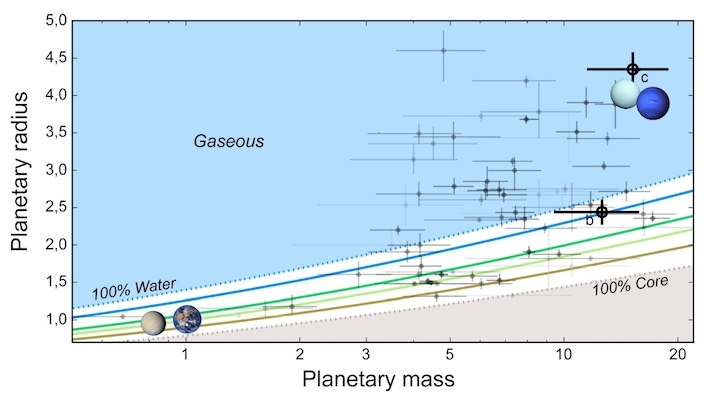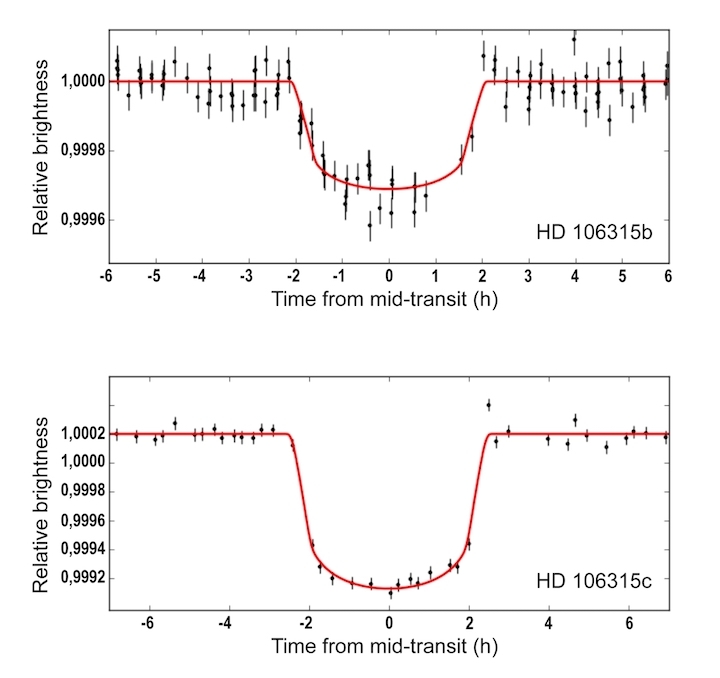1.04.2018

Mass-radius relationship for different compositions of small planets. Credit: Barros et. al, 2017
-
A team1 of astronomers from 11 countries, led by researchers at the Instituto de Astrofísica e Ciências do Espaço (IA2), were able to determine the precise mass of two small exoplanets orbiting the variable star HD 106315.
These two planets were previously detected by the Kepler satellite(NASA) with the transit method3, which allowed researchers to determine the diameter of the planets. HD 106315b has a period of 9,5 days and a diameter of 2,44 times the diameter of the Earth, while HD 106315c has an orbital period of about 21 days, and a diameter 4,35 times the diameter of the Earth.
But to characterize a planet (for example, to determine if it is gaseous or rocky, or whether they have an atmosphere), researchers also need to know the mass of the planet, measured by the radial velocities4, so that together with size, they can infer its density.
Susana Barros (IA & University of Porto), the first author of the paper5, explains the problem with this star: “The variability of HD 106315 was thought to be a source of too much noise for radial velocity observation, and therefore we couldn’t measure the mass of the two planets”.
Using data from a large observing program with the HARPSspectrograph (ESO), the IA team estimated the mass of the smaller planet HD 106315 b to be 12,6 times that of the Earth, and the density to be 4,7 g/cm3. For the larger planet, HD 106315 c, the derived mass is 15,2 times that of the Earth, with a density of 1,01 g/cm3. These values indicate that planet “c” has a thick hydrogen-helium envelope, while a detailed investigation of planet “b”, using planetary interior models, indicates at up to 50% of rocky material and 9 - 50% of water, making it a water world.
Nuno Santos (IA & Science Faculty of the University of Porto), leader of IA’s “Towards the detection and characterization of other Earths” thematic line adds: “Thanks to an intensive observation strategy and a sophisticated data analysis method developed by our team, we were able to determine the masses of these two planets and the composition of planet b”.
Susana Barros further points out that: “This planetary system showcases the diversity in the composition of planets, and since they transit a bright star, it will be possible to study their atmospheres. With current instruments, it’s currently possible to observe the atmosphere of planet c, but for planet b we will need to wait for instruments like the James Webb Space Telescope (JWST), to be launched in 2019”.
Probing atmospheres with upcoming new facilities like JWST (NASA) or ESO‘s Extremely Large Telescope (ELT) will help to better understand the composition of HD 106315 b, since this planet lies in the transition between rocky and gaseous planet composition.
Light Curve of the star HD 106315, with the transit of planet "b" (top) and "c" (bottom). Credit: Barros et. al, 2017
NOTES
1.The team is: S. C. C. Barros, V. Adibekyan, E. Delgado Mena, O. Demangeon, P. Figueira, J. J. Neal e S. G. Sousa (Instituto de Astrofísica e Ciências do Espaço & Universidade do Porto), J. P. Faria, N. C. Santos e S. Hojjatpanah (Instituto de Astrofísica e Ciências do Espaço & Dep. de Física e Astronomia, Faculdade de Ciências da Universidade do Porto); H. Gosselin (Aix Marseille U. Laboratoire d’Astrophysique de Marseille & Université de Toulouse); J. Lillo-Box e C. Melo (ESO); D. Bayliss, F. Bouchy, X. Dumusque, D. Ehrenreich, C. Lovis, S. Udry e A. Wyttenbach (Observatoire Astronomique de l’Universite de Geneve); B. Brugger, A. Santerne, Boisse, M. Deleuil, R. Ligi, O. Mousis e A. Vigan (Aix Marseille Université Laboratoire d’Astrophysique de Marseille); D. J. Armstrong, D. J. A. Brown, A. Doyle, F. Faedi, E. Foxell, J. Jackman, H. P. Osborn e D. Pollacco (Dep. of Physics, University of Warwick); J. D. Armstrong (Institute for Astronomy, University of Hawaii); D. Barrado (Depto. de Astrofísica, Centro de Astrobiología - CSIC-INTA); J. Bento (Research School of Astronomy and Astrophysics, Australian National University); I. A. S. Bonomo (INAF – Osservatorio Astrofisico di Torino); W. D. Cochran (McDonald Observatory and Department of Astronomy, The University of Texas at Austin); A. Collier Cameron (Centre for Exoplanet Science, SUPA School of Physics & Astronomy, University of St Andrews); R. F. Díaz (Observatoire Astronomique de l’Universite de Genev ; Universidad de Buenos Aires, Facultad de Ciencias Exactas y Naturales & Instituto de Astronomía y Física del Espacio - IAFE); N. Espinoza (Instituto de Astrofisica, Facultad de Fisica, Pontificia Universidad Catolica de Chile & Millennium Institute of Astrophysics); G. Hébrard (Institut d’Astrophysique de Paris, Universite Pierre & Marie Curie & Aix Marseille Université, Observatoire de Haute Provence); M. Lendl (Space Research Institute, Austrian Academy of Sciences); R. Sefako (South African Astronomical Observatory); A. Shporer (Division of Geological and Planetary Sciences, California Institute of Technology); A. H. M. J. Triaud (Institute of Astronomy, University of Cambridge).
2.The Instituto de Astrofísica e Ciências do Espaço (Institute of Astrophysics and Space Sciences – IA) is the reference Portuguese research unit in space sciences and integrates researchers from the University of Lisbon and the University of Porto. The institute encompasses most of the field’s national scientific output and it was evaluated as Excellent in the last evaluation Fundação para a Ciência e Tecnologia (FCT) commissioned from the European Science Foundation (ESF). IA's activity is funded by national and international funds, including Fundação para a Ciência e a Tecnologia (UID/FIS/04434/2013), POPH/FSE and FEDER through COMPETE 2020.
3.The Transits method measures the dimming of starlight produced when an exoplanet crosses in front of its star (something similar to a “micro-eclipse”). A transit enables for the determination of the planets’ radius only. It’s also a difficult method to use, because it requires that both planet and star be exactly be in line with the observers’ line of sight.
4. The Radial Velocity method detects exoplanets measuring tiny variations in the (radial) velocity of the star, due to the motion that an orbiting planet induces in the star. As an example, the speed variation that the Earth imprints in the Sun is of about 10 cm/s (about 0.36 km/h). With this method you can set a minimum value for the planets’ mass.
5. The article “Precise masses for the transiting planetary system HD 106315 with HARPS” was published in the journal Astronomy & Astrophysics Vol. 608, A25 (DOI: 10.1051/0004-6361/201731276).
Quelle: 
